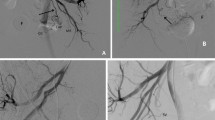Abstract
The aim of this study was to establish the imaging findings of the main branching patterns of the male internal iliac arteries, using different imaging modalities (angio MR, angio CT and digital angiography). Twenty-one males (mean age 73.2 years) underwent imaging evaluation with angio MR, angio CT and digital angiography to define the internal iliac artery anatomy before selective embolization of the pelvic arteries. All three modalities were used in 3 patients, angio MR and digital angiography in 17 patients, angio CT and digital angiography in 6 patients and only angio CT in 1 patient. Internal iliac arteries were classified into four groups using the Yamaki classification (modified from the Adachi’s classification). Twenty-six pelvic sides were classified as Group A (61.9%), 13 as Group B (31%) and 3 as Group C (7.1%) with no cases of Group D found. Angio MR, angio CT and digital angiography were able to detect most branches of the internal iliac artery. Group A was the most frequent internal iliac artery branching pattern. Angio CT showed better detailed anatomy than angio MR and digital angiography was considered the gold-standard. Non-invasive vascular imaging with angio MR or angio CT is essential before invasive interventions, allowing better planning of the procedure.







Similar content being viewed by others
References
Carnevale FC, Antunes AA, da Motta Leal Filho JM et al (2010) Prostatic artery embolization as a primary treatment for benign prostatic hyperplasia: preliminary results in two patients. Cardiovasc Interv Radiol 33:355–361
Ding HM, Yin ZX, Zhou XB, Li YB, Tang ML, Chen SH, Xu DC, Zhong SZ (2008) Three-dimensional visualization of pelvic vascularity. Surg Radiol Anat 30:437–442
Fang JF, Shih LY, Wong YC, Lin BC, Hsu YP (2009) Repeat transcatheter arterial embolization for the management of pelvic arterial hemorrhage. J Trauma 66:429–435
Goodwin SC, Spies JB (2009) Uterine fibroid embolization. N Engl J Med 361:690–697
Gray H, Carter HV (2005) Gray’s anatomy. Greenwich Editions, London
Kawanishi Y, Muguruma H, Sugiyama H, Kagawa J, Tanimoto S, Yamanaka M, Kojima K, Numata A, Kishimoto T, Nakanishi R, Kanayama HO (2008) Variations of the internal pudendal artery as a congenital contributing factor to age at onset of erectile dysfunction in Japanese. BJU Int 101:581–587
Mauro MA (2008) Can hyperplastic prostate follow uterine fibroids and be managed with transcatheter arterial embolization? Radiology 246:657–658
Mulhall JP, Secin FP, Guillonneau B (2008) Artery sparing radical prostatectomy—myth or reality? J Urol 179:827–831
Naguib NN, Nour-Eldin NE, Hammerstingl RM, Lehnert T, Floeter J, Zangos S, Vogl TJ (2008) Three-dimensional reconstructed contrast-enhanced MR angiography for internal iliac artery branch visualization before uterine artery embolization. J Vasc Interv Radiol 19:1569–1575
Ornan D, White R, Pollak J, Tal M (2003) Pelvic embolization for intractable postpartum hemorrhage: long-term follow-up and implications for fertility. Obstet Gynecol 102:904–910
Pisco JM, Martins JM, Correia MG (1989) Internal iliac artery: embolization to control hemorrhage from pelvic neoplasms. Radiology 172:337–339
Secin FP, Karanikolas N, Touijer AK, Salamanca JI, Vickers AJ, Guillonneau B (2005) Anatomy of accessory pudendal arteries in laparoscopic radical prostatectomy. J Urol 174:523–526
Venuti JM, Imielinska C, Molholt P (2004) New views of male pelvic anatomy: role of computer-generated 3D images. Clin Anat 17:261–271
Yamaki K, Saga T, Doi Y, Aida K, Yoshizuka M (1998) A statistical study of the branching of the human internal iliac artery. Kurume Med J 45:333–340
Conflict of interest
None.
Author information
Authors and Affiliations
Corresponding author
Rights and permissions
About this article
Cite this article
Bilhim, T., Casal, D., Furtado, A. et al. Branching patterns of the male internal iliac artery: imaging findings. Surg Radiol Anat 33, 151–159 (2011). https://doi.org/10.1007/s00276-010-0716-3
Received:
Accepted:
Published:
Issue Date:
DOI: https://doi.org/10.1007/s00276-010-0716-3




